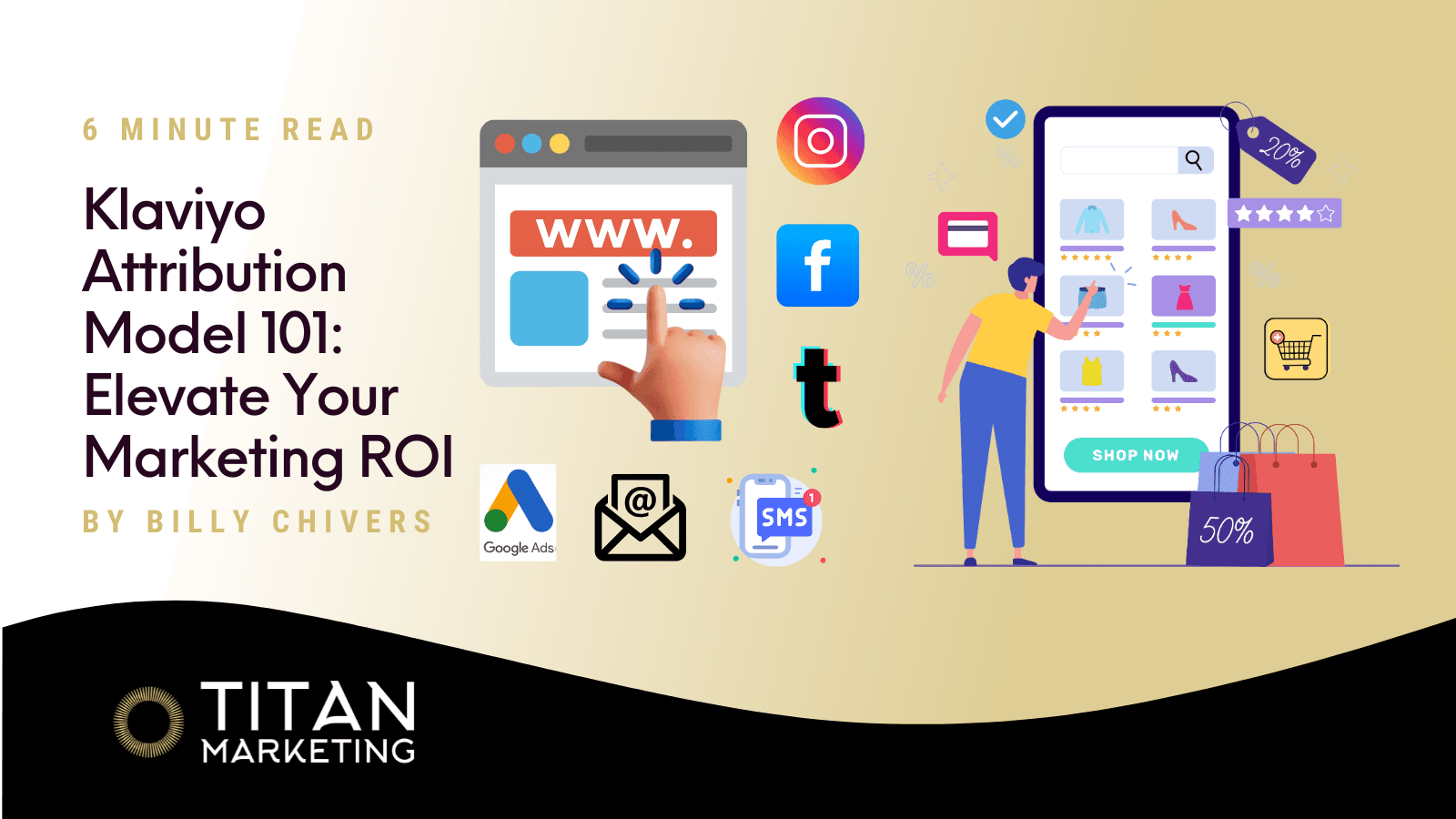
Blog
February 14, 2025

Blog
February 14, 2025

Blog
February 14, 2025
Learn how Klaviyo’s attribution model measures revenue, optimises spending, and helps you make data-driven decisions for higher ROI.
Are You Guessing or Tracking Your Marketing ROI?
Many brands struggle to measure the real impact of their marketing efforts. Without a reliable attribution model, knowing which touchpoints contribute to sales and where to invest your budget is hard.
The solution? Klaviyo’s attribution model. This guide will break down how Klaviyo tracks revenue, how to set up its attribution settings, and how to use its insights to improve your marketing ROI.
Section 1: What Is the Klaviyo Attribution Model?
Understanding Marketing Attribution & Why It Matters
Marketing attribution assigns credit to different touchpoints that influence a customer’s purchase. Like last-click attribution, traditional models often fail to capture the full journey, leading to misleading data. A solid attribution strategy helps brands:
Identify which marketing channels drive revenue.
Allocate budgets effectively.
Improve customer engagement based on actual interactions.
How Klaviyo’s Attribution Model Works
Klaviyo tracks revenue using two primary attribution models:
First-Touch Attribution: Assigns 100% of the revenue to the first marketing interaction a customer engages with.
Example: If a customer’s first interaction with your brand is a welcome email, that email will receive full credit for the sale, even if the customer engages with other marketing messages before purchasing.
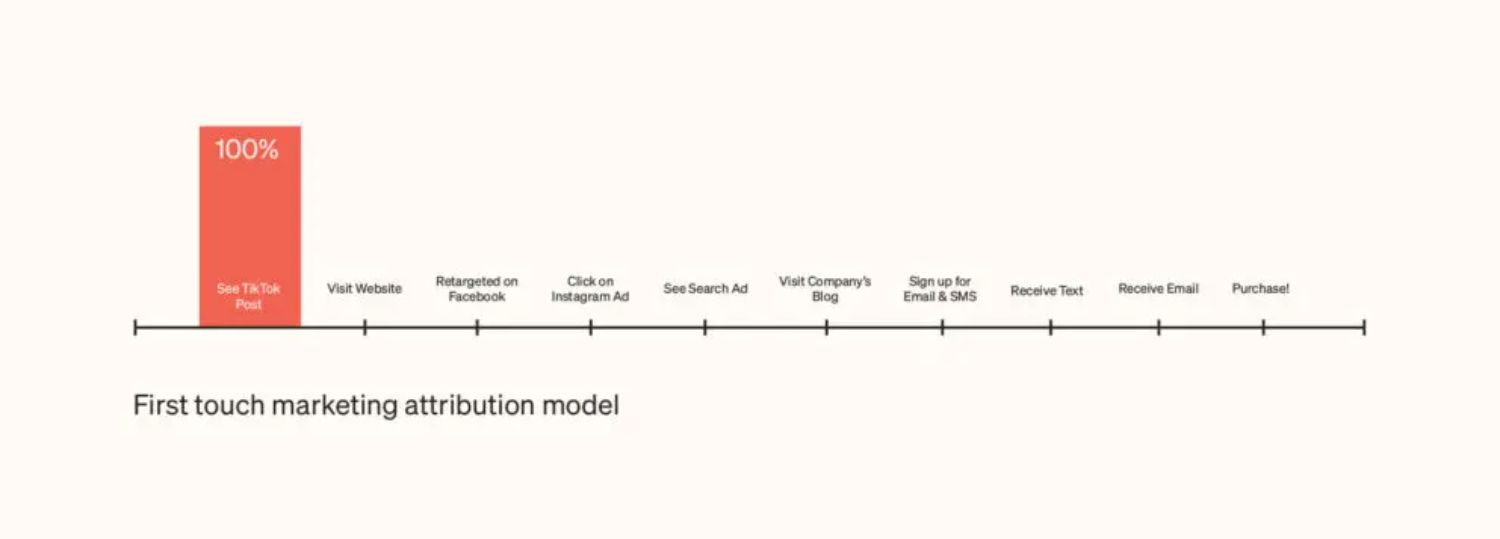
Source: Klaviyo
Last-Touch Attribution: Assigns 100% of the revenue to the last marketing touchpoint before the purchase.
Example: If a customer receives multiple emails and SMS messages but finally purchases after clicking an abandoned cart email, that email will be credited for the sale.
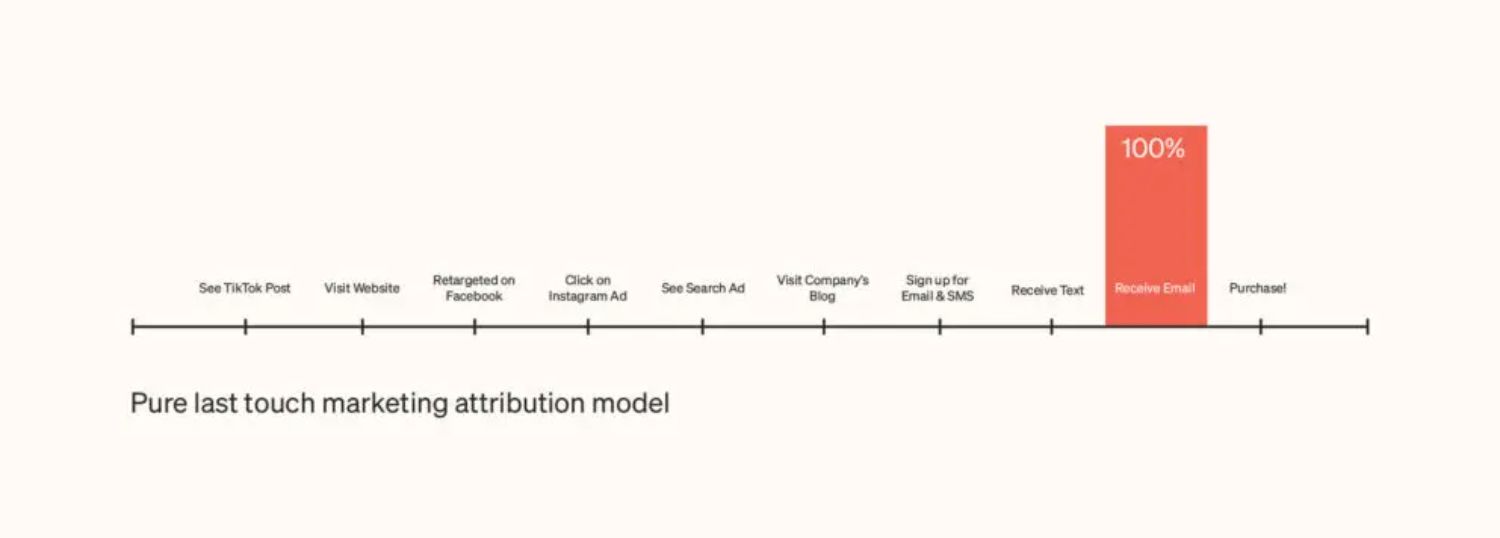
Source: Klaviyo
Example: A customer first clicks an SMS but later buys through an email. In Klaviyo, SMS gets credit under the first touch, while email gets credit under the last touch.
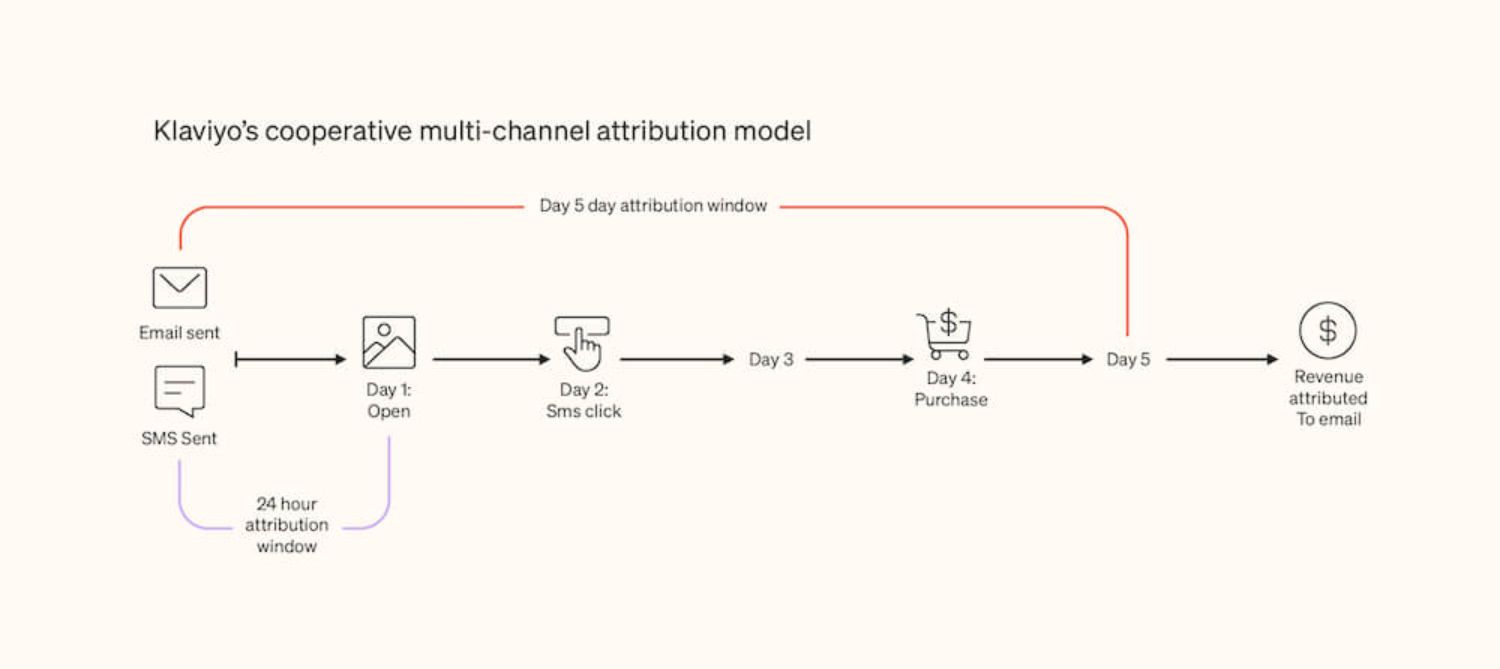
Source: Klaviyo
When Does Klaviyo Use Both?
Klaviyo tracks and reports both first-touch and last-touch revenue simultaneously, but how it applies them depends on the reporting view:
In Campaign Reports: You can see first-touch and last-touch revenue attribution for each email or SMS campaign.
In Flow Performance Reports: Klaviyo tracks revenue based on last-touch attribution by default, meaning the flow email/SMS that directly led to the purchase gets the credit.
Can You Choose Between First-Touch and Last-Touch?
Yes, Klaviyo allows you to adjust your attribution settings based on what’s most useful for your reporting needs. While Klaviyo automatically tracks both, businesses can customise attribution windows and preferences within their settings to refine how revenue is credited.
Klaviyo’s revenue tracking capabilities are especially useful for DTC brands looking to maximise email and SMS-driven sales. If you're already leveraging Klaviyo for customer retention, take it a step further with 8 Essential Klaviyo Flows to Boost Customer Loyalty.
Section 2: Setting Up & Customising Klaviyo’s Attribution Model
Enabling & Configuring Attribution in Klaviyo
To enable Klaviyo’s attribution model:
Go to Settings
Click on your account menu (bottom-left corner).
Select Settings > Attribution.
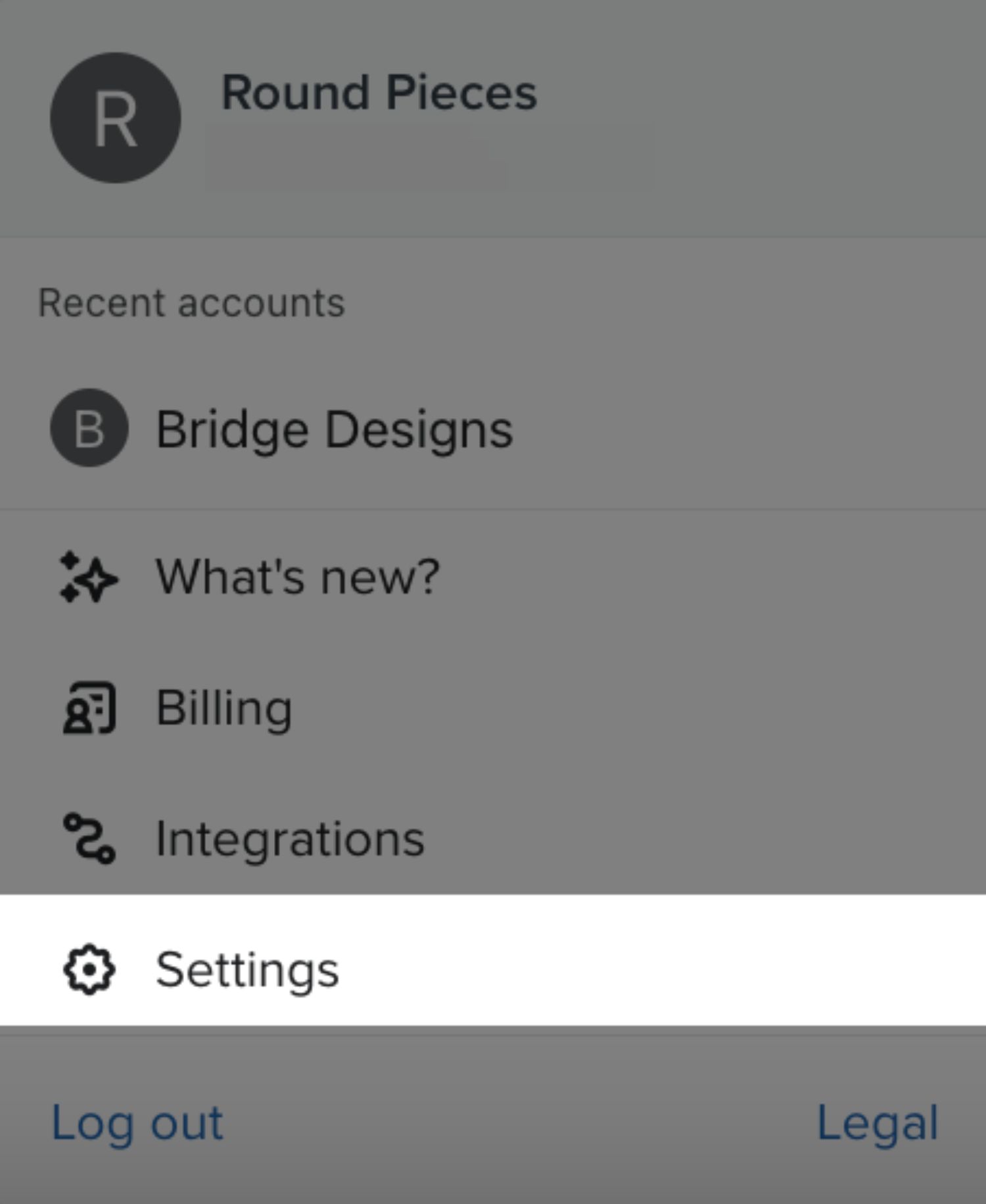
Source: Klaviyo
Set Attribution Windows
Expand Email, SMS, or Push sections.
Choose the interactions to track (clicks, opens, etc.).
Adjust the tracking window (hours or days).
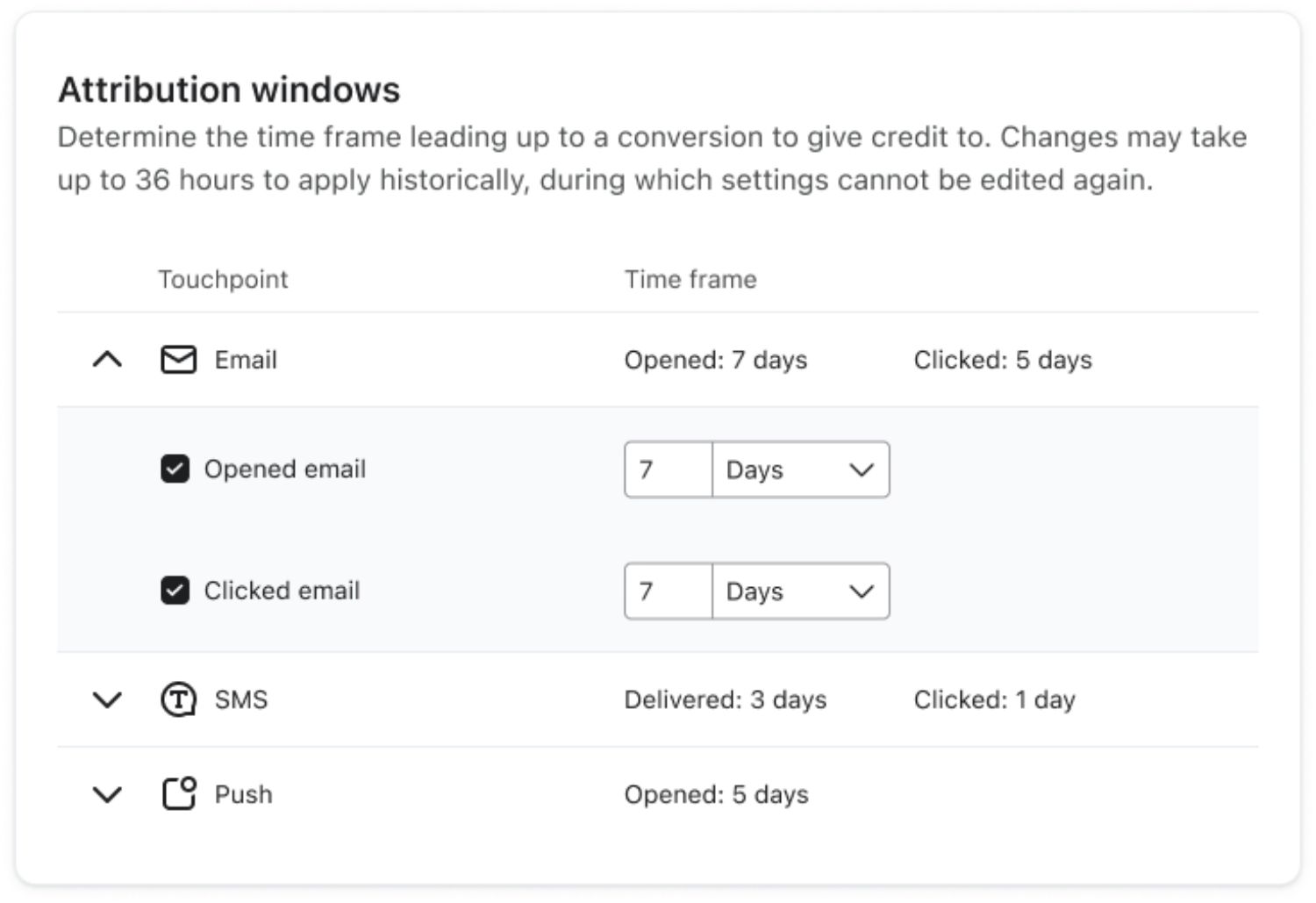
Source: Klaviyo
Save Changes
Click Save to apply your settings.
Choosing the Right Attribution Window in Klaviyo
An attribution window defines how long Klaviyo tracks conversions after a customer interacts with an email or SMS. Selecting the right window ensures accurate revenue reporting.
Klaviyo’s Default Attribution Windows
Email: 5 Days – Revenue is attributed if a customer clicks and purchases within 5 days. Ideal for nurturing sequences and promotions.
SMS: 24 Hours – Revenue is attributed if a customer clicks and purchases within 24 hours. Best for immediate, high-intent actions.
When to Adjust Your Attribution Window
Shorter Windows (1-3 Days for Email, 6-12 Hours for SMS) – Works for fast-moving products, flash sales, or impulse purchases.
Longer Windows (7-10 Days for Email, 2-3 Days for SMS) – Useful for high-ticket items or longer decision-making cycles.
Our Recommendation
We suggest sticking with Klaviyo’s defaults (5 days for email, 24 hours for SMS) as they align with customer behavior and industry benchmarks. This ensures:
✅ Consistent reporting across campaigns
✅ Accurate tracking of customer actions
✅ Reliable insights for data-driven decisions
Pro Tip: Start with defaults, track performance, and adjust only if your data shows a clear need.
Section 3: How to Choose the Right Attribution Tool
Google Analytics: Strengths and Limitations in Attribution
Google Analytics provides multiple attribution models, including linear and data-driven attribution, to help businesses analyze customer journeys. However, GA4 often underreports email revenue due to cross-device tracking limitations. Since GA4 relies on cookie-based tracking, it struggles to connect user interactions across multiple devices, leading to attribution gaps.
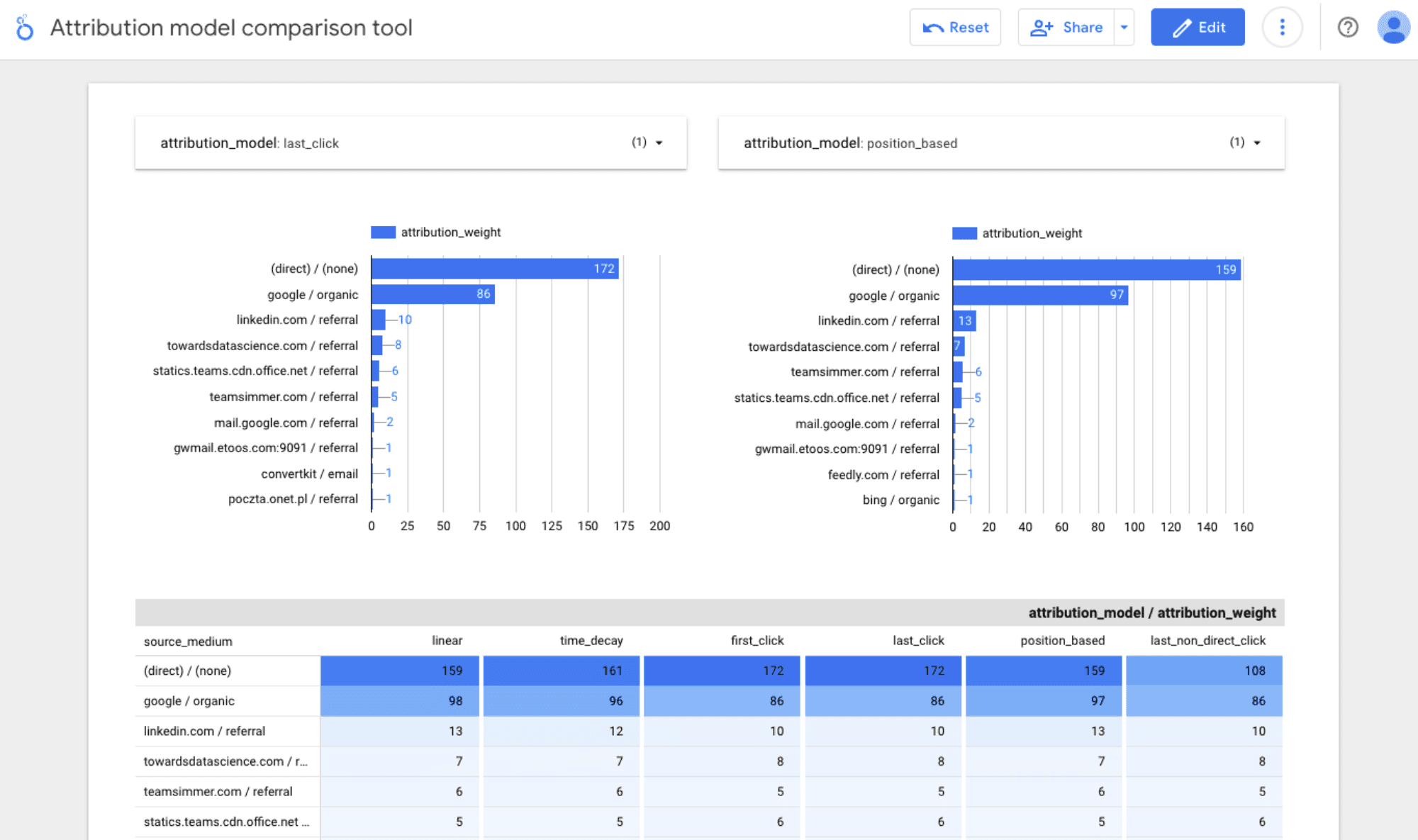
Source: GA4BigQuery
In contrast, Klaviyo tracks interactions directly within its platform, capturing email and SMS engagement more accurately. This makes Klaviyo a more reliable choice for businesses prioritizing lifecycle marketing, while GA4 remains useful for a broader multi-channel performance overview.
If you’re using both Google Ads and Klaviyo, integrating them properly ensures that attribution data is accurate across platforms. Follow our Klaviyo x Google Ads: A Step-by-Step Guide to Seamless Integration to improve tracking.
Triple Whale & Multi-Channel Attribution
For brands using multiple marketing channels (Google Ads, Facebook, TikTok, etc.), Triple Whale provides a more integrated view. It connects with Klaviyo to track cross-channel conversions and helps businesses see how different touchpoints contribute to purchases.

Source: Triple Whale
If you're running Shopify, Facebook Ads, and Klaviyo, a seamless integration between them can improve reporting. Our guide on Shopify x Klaviyo: The Ultimate Integration Guide ensures that your data flows correctly.
Comparison of Klaviyo, Google Analytics (GA4), and Triple Whale Attribution Models
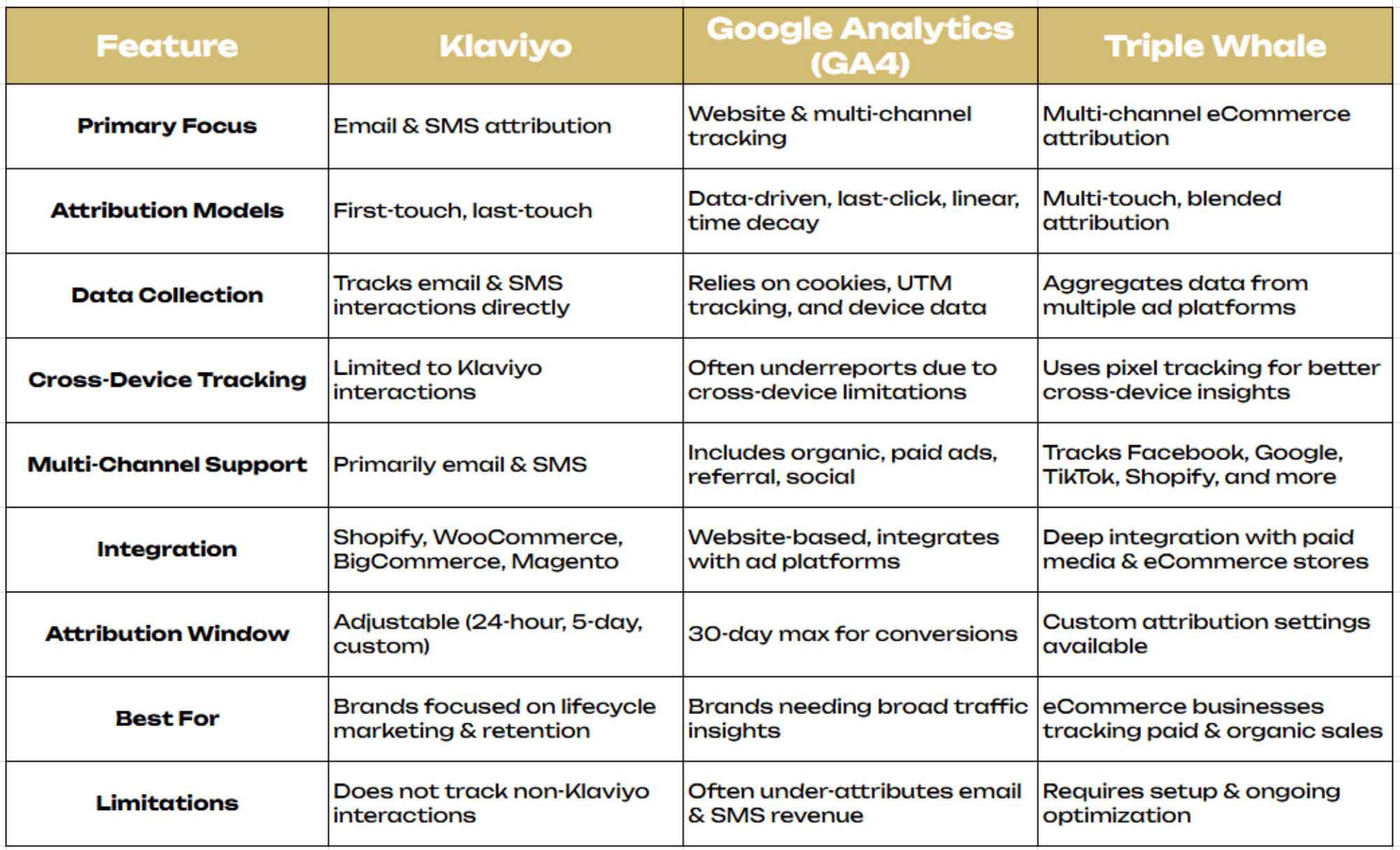
Which Attribution Model Should I Trust?
Key Perspective: "The most accurate attribution is a consistent one."
Rather than aggregating data from multiple platforms (Klaviyo, Triple Whale, and GA4) all at once, it’s best to pick one system and stick with it. The key metrics that determine growth, such as revenue, conversion rates, and customer engagement, will either rise or fall. As long as trends are analyzed within a single system, businesses will have a reliable understanding of performance.
However, GA4’s data-driven attribution often under-reports Klaviyo’s performance by nearly 50%. While GA4 and Triple Whale provide a holistic view of business performance, Klaviyo is more precise when tracking email and SMS-driven revenue.
Takeaway:
Klaviyo is best for tracking revenue from email and SMS campaigns, making it ideal for lifecycle marketing.
Google Analytics (GA4) provides broad website tracking but often underreports email and SMS conversions.
Triple Whale is optimized for eCommerce businesses that need a holistic view of multiple paid and organic channels.
Section 4: Advanced Attribution Strategies for Better ROI
Why You Shouldn’t Rely on Just One Model
Multi-touch attribution tracks the entire customer journey, rather than just one interaction. Klaviyo’s analytics allow you to:
Monitor how multiple touchpoints contribute to conversions.
Identify which channels work best at different stages.
Adjust marketing efforts based on full-funnel insights.
Klaviyo’s attribution model works best when combined with advanced segmentation strategies to target high-value customers more effectively. Get inspired by 3 Klaviyo Segmentation Strategies to Boost DTC Sales.
Attribution & Budget Optimisation
Attribution insights help marketers decide where to invest more budget:
If SMS drives more conversions, allocate more budget to SMS campaigns.
If email performs better, double down on email automation.
If both work together, create cross-channel strategies.
Klaviyo has developed a model comparison tool that enables businesses to explore different attribution settings before making any changes, helping them select the most effective approach for their marketing strategy.
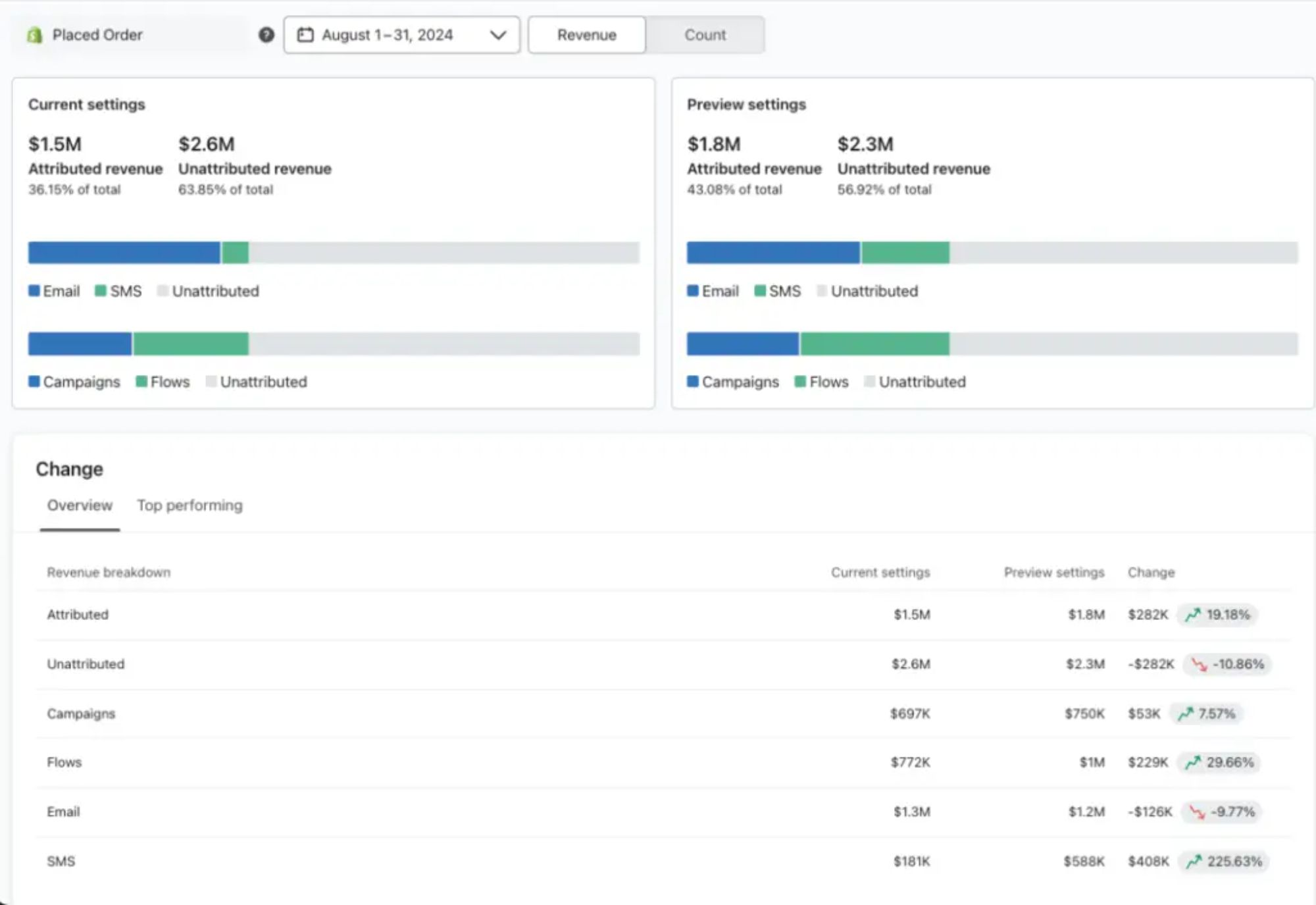
Source: Klaviyo
Section 5: Common Attribution Challenges & How to Fix Them
Attribution tracking is essential for measuring marketing success, but misconfigurations can lead to inaccurate revenue reporting and data mismatches. Below are common attribution errors and how to resolve them.
The Most Common Attribution Errors
Revenue Misattribution
Incorrectly credited revenue can distort campaign performance and budget allocation.
Fix:
Ensure Klaviyo’s attribution settings align with your reporting needs.
Use UTM parameters consistently across campaigns.
Compare Klaviyo-reported revenue with actual order data.
Attribution Window Mismatches
Different attribution windows can result in inconsistent revenue reporting.
Fix:
Adjust Klaviyo’s attribution window to reflect your sales cycle.
Test different windows to determine the most accurate conversion insights.
Understanding customer lifetime value and retention metrics is essential for selecting the right attribution window. Our article on Customer Lifetime Value in Marketing: Strategies to Maximise ROI explains how to measure and optimize for long-term profitability.
Klaviyo vs. Shopify Discrepancies
Klaviyo tracks marketing-driven conversions, while Shopify logs all transactions.
Fix:
Understand that Klaviyo only tracks revenue influenced by email or SMS.
Cross-check Klaviyo data with Shopify’s total revenue for a clearer performance picture.
Troubleshooting Klaviyo’s Attribution Model
No Attributed Revenue?
Check UTM parameters and ensure click tracking is enabled.
Verify if ad blockers or privacy settings are blocking data.
Data Mismatches?
Ensure Google Analytics, Shopify, and Klaviyo are properly synced.
Use Klaviyo’s model comparison tool before adjusting settings.
If revenue is misattributed or missing, test your email campaign structure and A/B testing strategy to refine what’s working. Read 10 Essential A/B Tests to Boost Email Conversions for insights.
Conclusion: Make Smarter Marketing Decisions with Klaviyo Attribution
Accurate attribution is the key to scaling marketing efforts effectively. Without it, businesses risk misallocating budgets, underreporting revenue, and missing key insights on customer behaviour.
Klaviyo’s attribution model simplifies revenue tracking by giving clear visibility into which campaigns, touchpoints, and channels generate the most conversions.
By leveraging first-touch, last-touch, and multi-touch attribution, marketers can improve engagement, refine targeting, and maximize ROI. Whether you use Klaviyo alone or integrate it with Google Analytics or Triple Whale, choosing a consistent attribution method is the key to long-term success.
Key Takeaways
Understand How Klaviyo Assigns Revenue – Learn how first-touch and last-touch attribution models work.
Enable & Customize Attribution Settings – Set up Klaviyo’s attribution model to match your business needs.
Choose the Right Attribution Window – Adjust tracking timeframes for more accurate revenue reporting.
Compare Klaviyo, Google Analytics & Triple Whale – Identify which tool best fits your marketing goals.
Leverage Multi-Touch Attribution – Track customer journeys across multiple channels for better insights.
Optimize Marketing Spend with Data – Shift budget toward high-performing email and SMS campaigns.
Fix Revenue Attribution Errors – Resolve common issues like tracking mismatches and integration problems.
Improve Cross-Channel Performance – Use attribution insights to refine email, SMS, and paid ad strategies.
Troubleshoot Data Discrepancies – Ensure proper tracking across Klaviyo, Google Analytics, and Shopify.
Future-Proof Your Marketing Strategy – Use data-driven decisions to maximize engagement and conversions.
Tired of unclear revenue attribution and misleading data?
Stop guessing which campaigns drive sales. Let us refine your Klaviyo attribution model for confident tracking, optimised spending, and higher ROI. Click here to get a free audit with our experts!
Are You Guessing or Tracking Your Marketing ROI?
Many brands struggle to measure the real impact of their marketing efforts. Without a reliable attribution model, knowing which touchpoints contribute to sales and where to invest your budget is hard.
The solution? Klaviyo’s attribution model. This guide will break down how Klaviyo tracks revenue, how to set up its attribution settings, and how to use its insights to improve your marketing ROI.
Section 1: What Is the Klaviyo Attribution Model?
Understanding Marketing Attribution & Why It Matters
Marketing attribution assigns credit to different touchpoints that influence a customer’s purchase. Like last-click attribution, traditional models often fail to capture the full journey, leading to misleading data. A solid attribution strategy helps brands:
Identify which marketing channels drive revenue.
Allocate budgets effectively.
Improve customer engagement based on actual interactions.
How Klaviyo’s Attribution Model Works
Klaviyo tracks revenue using two primary attribution models:
First-Touch Attribution: Assigns 100% of the revenue to the first marketing interaction a customer engages with.
Example: If a customer’s first interaction with your brand is a welcome email, that email will receive full credit for the sale, even if the customer engages with other marketing messages before purchasing.

Source: Klaviyo
Last-Touch Attribution: Assigns 100% of the revenue to the last marketing touchpoint before the purchase.
Example: If a customer receives multiple emails and SMS messages but finally purchases after clicking an abandoned cart email, that email will be credited for the sale.

Source: Klaviyo
Example: A customer first clicks an SMS but later buys through an email. In Klaviyo, SMS gets credit under the first touch, while email gets credit under the last touch.

Source: Klaviyo
When Does Klaviyo Use Both?
Klaviyo tracks and reports both first-touch and last-touch revenue simultaneously, but how it applies them depends on the reporting view:
In Campaign Reports: You can see first-touch and last-touch revenue attribution for each email or SMS campaign.
In Flow Performance Reports: Klaviyo tracks revenue based on last-touch attribution by default, meaning the flow email/SMS that directly led to the purchase gets the credit.
Can You Choose Between First-Touch and Last-Touch?
Yes, Klaviyo allows you to adjust your attribution settings based on what’s most useful for your reporting needs. While Klaviyo automatically tracks both, businesses can customise attribution windows and preferences within their settings to refine how revenue is credited.
Klaviyo’s revenue tracking capabilities are especially useful for DTC brands looking to maximise email and SMS-driven sales. If you're already leveraging Klaviyo for customer retention, take it a step further with 8 Essential Klaviyo Flows to Boost Customer Loyalty.
Section 2: Setting Up & Customising Klaviyo’s Attribution Model
Enabling & Configuring Attribution in Klaviyo
To enable Klaviyo’s attribution model:
Go to Settings
Click on your account menu (bottom-left corner).
Select Settings > Attribution.

Source: Klaviyo
Set Attribution Windows
Expand Email, SMS, or Push sections.
Choose the interactions to track (clicks, opens, etc.).
Adjust the tracking window (hours or days).

Source: Klaviyo
Save Changes
Click Save to apply your settings.
Choosing the Right Attribution Window in Klaviyo
An attribution window defines how long Klaviyo tracks conversions after a customer interacts with an email or SMS. Selecting the right window ensures accurate revenue reporting.
Klaviyo’s Default Attribution Windows
Email: 5 Days – Revenue is attributed if a customer clicks and purchases within 5 days. Ideal for nurturing sequences and promotions.
SMS: 24 Hours – Revenue is attributed if a customer clicks and purchases within 24 hours. Best for immediate, high-intent actions.
When to Adjust Your Attribution Window
Shorter Windows (1-3 Days for Email, 6-12 Hours for SMS) – Works for fast-moving products, flash sales, or impulse purchases.
Longer Windows (7-10 Days for Email, 2-3 Days for SMS) – Useful for high-ticket items or longer decision-making cycles.
Our Recommendation
We suggest sticking with Klaviyo’s defaults (5 days for email, 24 hours for SMS) as they align with customer behavior and industry benchmarks. This ensures:
✅ Consistent reporting across campaigns
✅ Accurate tracking of customer actions
✅ Reliable insights for data-driven decisions
Pro Tip: Start with defaults, track performance, and adjust only if your data shows a clear need.
Section 3: How to Choose the Right Attribution Tool
Google Analytics: Strengths and Limitations in Attribution
Google Analytics provides multiple attribution models, including linear and data-driven attribution, to help businesses analyze customer journeys. However, GA4 often underreports email revenue due to cross-device tracking limitations. Since GA4 relies on cookie-based tracking, it struggles to connect user interactions across multiple devices, leading to attribution gaps.

Source: GA4BigQuery
In contrast, Klaviyo tracks interactions directly within its platform, capturing email and SMS engagement more accurately. This makes Klaviyo a more reliable choice for businesses prioritizing lifecycle marketing, while GA4 remains useful for a broader multi-channel performance overview.
If you’re using both Google Ads and Klaviyo, integrating them properly ensures that attribution data is accurate across platforms. Follow our Klaviyo x Google Ads: A Step-by-Step Guide to Seamless Integration to improve tracking.
Triple Whale & Multi-Channel Attribution
For brands using multiple marketing channels (Google Ads, Facebook, TikTok, etc.), Triple Whale provides a more integrated view. It connects with Klaviyo to track cross-channel conversions and helps businesses see how different touchpoints contribute to purchases.

Source: Triple Whale
If you're running Shopify, Facebook Ads, and Klaviyo, a seamless integration between them can improve reporting. Our guide on Shopify x Klaviyo: The Ultimate Integration Guide ensures that your data flows correctly.
Comparison of Klaviyo, Google Analytics (GA4), and Triple Whale Attribution Models

Which Attribution Model Should I Trust?
Key Perspective: "The most accurate attribution is a consistent one."
Rather than aggregating data from multiple platforms (Klaviyo, Triple Whale, and GA4) all at once, it’s best to pick one system and stick with it. The key metrics that determine growth, such as revenue, conversion rates, and customer engagement, will either rise or fall. As long as trends are analyzed within a single system, businesses will have a reliable understanding of performance.
However, GA4’s data-driven attribution often under-reports Klaviyo’s performance by nearly 50%. While GA4 and Triple Whale provide a holistic view of business performance, Klaviyo is more precise when tracking email and SMS-driven revenue.
Takeaway:
Klaviyo is best for tracking revenue from email and SMS campaigns, making it ideal for lifecycle marketing.
Google Analytics (GA4) provides broad website tracking but often underreports email and SMS conversions.
Triple Whale is optimized for eCommerce businesses that need a holistic view of multiple paid and organic channels.
Section 4: Advanced Attribution Strategies for Better ROI
Why You Shouldn’t Rely on Just One Model
Multi-touch attribution tracks the entire customer journey, rather than just one interaction. Klaviyo’s analytics allow you to:
Monitor how multiple touchpoints contribute to conversions.
Identify which channels work best at different stages.
Adjust marketing efforts based on full-funnel insights.
Klaviyo’s attribution model works best when combined with advanced segmentation strategies to target high-value customers more effectively. Get inspired by 3 Klaviyo Segmentation Strategies to Boost DTC Sales.
Attribution & Budget Optimisation
Attribution insights help marketers decide where to invest more budget:
If SMS drives more conversions, allocate more budget to SMS campaigns.
If email performs better, double down on email automation.
If both work together, create cross-channel strategies.
Klaviyo has developed a model comparison tool that enables businesses to explore different attribution settings before making any changes, helping them select the most effective approach for their marketing strategy.

Source: Klaviyo
Section 5: Common Attribution Challenges & How to Fix Them
Attribution tracking is essential for measuring marketing success, but misconfigurations can lead to inaccurate revenue reporting and data mismatches. Below are common attribution errors and how to resolve them.
The Most Common Attribution Errors
Revenue Misattribution
Incorrectly credited revenue can distort campaign performance and budget allocation.
Fix:
Ensure Klaviyo’s attribution settings align with your reporting needs.
Use UTM parameters consistently across campaigns.
Compare Klaviyo-reported revenue with actual order data.
Attribution Window Mismatches
Different attribution windows can result in inconsistent revenue reporting.
Fix:
Adjust Klaviyo’s attribution window to reflect your sales cycle.
Test different windows to determine the most accurate conversion insights.
Understanding customer lifetime value and retention metrics is essential for selecting the right attribution window. Our article on Customer Lifetime Value in Marketing: Strategies to Maximise ROI explains how to measure and optimize for long-term profitability.
Klaviyo vs. Shopify Discrepancies
Klaviyo tracks marketing-driven conversions, while Shopify logs all transactions.
Fix:
Understand that Klaviyo only tracks revenue influenced by email or SMS.
Cross-check Klaviyo data with Shopify’s total revenue for a clearer performance picture.
Troubleshooting Klaviyo’s Attribution Model
No Attributed Revenue?
Check UTM parameters and ensure click tracking is enabled.
Verify if ad blockers or privacy settings are blocking data.
Data Mismatches?
Ensure Google Analytics, Shopify, and Klaviyo are properly synced.
Use Klaviyo’s model comparison tool before adjusting settings.
If revenue is misattributed or missing, test your email campaign structure and A/B testing strategy to refine what’s working. Read 10 Essential A/B Tests to Boost Email Conversions for insights.
Conclusion: Make Smarter Marketing Decisions with Klaviyo Attribution
Accurate attribution is the key to scaling marketing efforts effectively. Without it, businesses risk misallocating budgets, underreporting revenue, and missing key insights on customer behaviour.
Klaviyo’s attribution model simplifies revenue tracking by giving clear visibility into which campaigns, touchpoints, and channels generate the most conversions.
By leveraging first-touch, last-touch, and multi-touch attribution, marketers can improve engagement, refine targeting, and maximize ROI. Whether you use Klaviyo alone or integrate it with Google Analytics or Triple Whale, choosing a consistent attribution method is the key to long-term success.
Key Takeaways
Understand How Klaviyo Assigns Revenue – Learn how first-touch and last-touch attribution models work.
Enable & Customize Attribution Settings – Set up Klaviyo’s attribution model to match your business needs.
Choose the Right Attribution Window – Adjust tracking timeframes for more accurate revenue reporting.
Compare Klaviyo, Google Analytics & Triple Whale – Identify which tool best fits your marketing goals.
Leverage Multi-Touch Attribution – Track customer journeys across multiple channels for better insights.
Optimize Marketing Spend with Data – Shift budget toward high-performing email and SMS campaigns.
Fix Revenue Attribution Errors – Resolve common issues like tracking mismatches and integration problems.
Improve Cross-Channel Performance – Use attribution insights to refine email, SMS, and paid ad strategies.
Troubleshoot Data Discrepancies – Ensure proper tracking across Klaviyo, Google Analytics, and Shopify.
Future-Proof Your Marketing Strategy – Use data-driven decisions to maximize engagement and conversions.
Tired of unclear revenue attribution and misleading data?
Stop guessing which campaigns drive sales. Let us refine your Klaviyo attribution model for confident tracking, optimised spending, and higher ROI. Click here to get a free audit with our experts!
Learn how Klaviyo’s attribution model measures revenue, optimises spending, and helps you make data-driven decisions for higher ROI.
Are You Guessing or Tracking Your Marketing ROI?
Many brands struggle to measure the real impact of their marketing efforts. Without a reliable attribution model, knowing which touchpoints contribute to sales and where to invest your budget is hard.
The solution? Klaviyo’s attribution model. This guide will break down how Klaviyo tracks revenue, how to set up its attribution settings, and how to use its insights to improve your marketing ROI.
Section 1: What Is the Klaviyo Attribution Model?
Understanding Marketing Attribution & Why It Matters
Marketing attribution assigns credit to different touchpoints that influence a customer’s purchase. Like last-click attribution, traditional models often fail to capture the full journey, leading to misleading data. A solid attribution strategy helps brands:
Identify which marketing channels drive revenue.
Allocate budgets effectively.
Improve customer engagement based on actual interactions.
How Klaviyo’s Attribution Model Works
Klaviyo tracks revenue using two primary attribution models:
First-Touch Attribution: Assigns 100% of the revenue to the first marketing interaction a customer engages with.
Example: If a customer’s first interaction with your brand is a welcome email, that email will receive full credit for the sale, even if the customer engages with other marketing messages before purchasing.

Source: Klaviyo
Last-Touch Attribution: Assigns 100% of the revenue to the last marketing touchpoint before the purchase.
Example: If a customer receives multiple emails and SMS messages but finally purchases after clicking an abandoned cart email, that email will be credited for the sale.

Source: Klaviyo
Example: A customer first clicks an SMS but later buys through an email. In Klaviyo, SMS gets credit under the first touch, while email gets credit under the last touch.

Source: Klaviyo
When Does Klaviyo Use Both?
Klaviyo tracks and reports both first-touch and last-touch revenue simultaneously, but how it applies them depends on the reporting view:
In Campaign Reports: You can see first-touch and last-touch revenue attribution for each email or SMS campaign.
In Flow Performance Reports: Klaviyo tracks revenue based on last-touch attribution by default, meaning the flow email/SMS that directly led to the purchase gets the credit.
Can You Choose Between First-Touch and Last-Touch?
Yes, Klaviyo allows you to adjust your attribution settings based on what’s most useful for your reporting needs. While Klaviyo automatically tracks both, businesses can customise attribution windows and preferences within their settings to refine how revenue is credited.
Klaviyo’s revenue tracking capabilities are especially useful for DTC brands looking to maximise email and SMS-driven sales. If you're already leveraging Klaviyo for customer retention, take it a step further with 8 Essential Klaviyo Flows to Boost Customer Loyalty.
Section 2: Setting Up & Customising Klaviyo’s Attribution Model
Enabling & Configuring Attribution in Klaviyo
To enable Klaviyo’s attribution model:
Go to Settings
Click on your account menu (bottom-left corner).
Select Settings > Attribution.

Source: Klaviyo
Set Attribution Windows
Expand Email, SMS, or Push sections.
Choose the interactions to track (clicks, opens, etc.).
Adjust the tracking window (hours or days).

Source: Klaviyo
Save Changes
Click Save to apply your settings.
Choosing the Right Attribution Window in Klaviyo
An attribution window defines how long Klaviyo tracks conversions after a customer interacts with an email or SMS. Selecting the right window ensures accurate revenue reporting.
Klaviyo’s Default Attribution Windows
Email: 5 Days – Revenue is attributed if a customer clicks and purchases within 5 days. Ideal for nurturing sequences and promotions.
SMS: 24 Hours – Revenue is attributed if a customer clicks and purchases within 24 hours. Best for immediate, high-intent actions.
When to Adjust Your Attribution Window
Shorter Windows (1-3 Days for Email, 6-12 Hours for SMS) – Works for fast-moving products, flash sales, or impulse purchases.
Longer Windows (7-10 Days for Email, 2-3 Days for SMS) – Useful for high-ticket items or longer decision-making cycles.
Our Recommendation
We suggest sticking with Klaviyo’s defaults (5 days for email, 24 hours for SMS) as they align with customer behavior and industry benchmarks. This ensures:
✅ Consistent reporting across campaigns
✅ Accurate tracking of customer actions
✅ Reliable insights for data-driven decisions
Pro Tip: Start with defaults, track performance, and adjust only if your data shows a clear need.
Section 3: How to Choose the Right Attribution Tool
Google Analytics: Strengths and Limitations in Attribution
Google Analytics provides multiple attribution models, including linear and data-driven attribution, to help businesses analyze customer journeys. However, GA4 often underreports email revenue due to cross-device tracking limitations. Since GA4 relies on cookie-based tracking, it struggles to connect user interactions across multiple devices, leading to attribution gaps.

Source: GA4BigQuery
In contrast, Klaviyo tracks interactions directly within its platform, capturing email and SMS engagement more accurately. This makes Klaviyo a more reliable choice for businesses prioritizing lifecycle marketing, while GA4 remains useful for a broader multi-channel performance overview.
If you’re using both Google Ads and Klaviyo, integrating them properly ensures that attribution data is accurate across platforms. Follow our Klaviyo x Google Ads: A Step-by-Step Guide to Seamless Integration to improve tracking.
Triple Whale & Multi-Channel Attribution
For brands using multiple marketing channels (Google Ads, Facebook, TikTok, etc.), Triple Whale provides a more integrated view. It connects with Klaviyo to track cross-channel conversions and helps businesses see how different touchpoints contribute to purchases.

Source: Triple Whale
If you're running Shopify, Facebook Ads, and Klaviyo, a seamless integration between them can improve reporting. Our guide on Shopify x Klaviyo: The Ultimate Integration Guide ensures that your data flows correctly.
Comparison of Klaviyo, Google Analytics (GA4), and Triple Whale Attribution Models

Which Attribution Model Should I Trust?
Key Perspective: "The most accurate attribution is a consistent one."
Rather than aggregating data from multiple platforms (Klaviyo, Triple Whale, and GA4) all at once, it’s best to pick one system and stick with it. The key metrics that determine growth, such as revenue, conversion rates, and customer engagement, will either rise or fall. As long as trends are analyzed within a single system, businesses will have a reliable understanding of performance.
However, GA4’s data-driven attribution often under-reports Klaviyo’s performance by nearly 50%. While GA4 and Triple Whale provide a holistic view of business performance, Klaviyo is more precise when tracking email and SMS-driven revenue.
Takeaway:
Klaviyo is best for tracking revenue from email and SMS campaigns, making it ideal for lifecycle marketing.
Google Analytics (GA4) provides broad website tracking but often underreports email and SMS conversions.
Triple Whale is optimized for eCommerce businesses that need a holistic view of multiple paid and organic channels.
Section 4: Advanced Attribution Strategies for Better ROI
Why You Shouldn’t Rely on Just One Model
Multi-touch attribution tracks the entire customer journey, rather than just one interaction. Klaviyo’s analytics allow you to:
Monitor how multiple touchpoints contribute to conversions.
Identify which channels work best at different stages.
Adjust marketing efforts based on full-funnel insights.
Klaviyo’s attribution model works best when combined with advanced segmentation strategies to target high-value customers more effectively. Get inspired by 3 Klaviyo Segmentation Strategies to Boost DTC Sales.
Attribution & Budget Optimisation
Attribution insights help marketers decide where to invest more budget:
If SMS drives more conversions, allocate more budget to SMS campaigns.
If email performs better, double down on email automation.
If both work together, create cross-channel strategies.
Klaviyo has developed a model comparison tool that enables businesses to explore different attribution settings before making any changes, helping them select the most effective approach for their marketing strategy.

Source: Klaviyo
Section 5: Common Attribution Challenges & How to Fix Them
Attribution tracking is essential for measuring marketing success, but misconfigurations can lead to inaccurate revenue reporting and data mismatches. Below are common attribution errors and how to resolve them.
The Most Common Attribution Errors
Revenue Misattribution
Incorrectly credited revenue can distort campaign performance and budget allocation.
Fix:
Ensure Klaviyo’s attribution settings align with your reporting needs.
Use UTM parameters consistently across campaigns.
Compare Klaviyo-reported revenue with actual order data.
Attribution Window Mismatches
Different attribution windows can result in inconsistent revenue reporting.
Fix:
Adjust Klaviyo’s attribution window to reflect your sales cycle.
Test different windows to determine the most accurate conversion insights.
Understanding customer lifetime value and retention metrics is essential for selecting the right attribution window. Our article on Customer Lifetime Value in Marketing: Strategies to Maximise ROI explains how to measure and optimize for long-term profitability.
Klaviyo vs. Shopify Discrepancies
Klaviyo tracks marketing-driven conversions, while Shopify logs all transactions.
Fix:
Understand that Klaviyo only tracks revenue influenced by email or SMS.
Cross-check Klaviyo data with Shopify’s total revenue for a clearer performance picture.
Troubleshooting Klaviyo’s Attribution Model
No Attributed Revenue?
Check UTM parameters and ensure click tracking is enabled.
Verify if ad blockers or privacy settings are blocking data.
Data Mismatches?
Ensure Google Analytics, Shopify, and Klaviyo are properly synced.
Use Klaviyo’s model comparison tool before adjusting settings.
If revenue is misattributed or missing, test your email campaign structure and A/B testing strategy to refine what’s working. Read 10 Essential A/B Tests to Boost Email Conversions for insights.
Conclusion: Make Smarter Marketing Decisions with Klaviyo Attribution
Accurate attribution is the key to scaling marketing efforts effectively. Without it, businesses risk misallocating budgets, underreporting revenue, and missing key insights on customer behaviour.
Klaviyo’s attribution model simplifies revenue tracking by giving clear visibility into which campaigns, touchpoints, and channels generate the most conversions.
By leveraging first-touch, last-touch, and multi-touch attribution, marketers can improve engagement, refine targeting, and maximize ROI. Whether you use Klaviyo alone or integrate it with Google Analytics or Triple Whale, choosing a consistent attribution method is the key to long-term success.
Key Takeaways
Understand How Klaviyo Assigns Revenue – Learn how first-touch and last-touch attribution models work.
Enable & Customize Attribution Settings – Set up Klaviyo’s attribution model to match your business needs.
Choose the Right Attribution Window – Adjust tracking timeframes for more accurate revenue reporting.
Compare Klaviyo, Google Analytics & Triple Whale – Identify which tool best fits your marketing goals.
Leverage Multi-Touch Attribution – Track customer journeys across multiple channels for better insights.
Optimize Marketing Spend with Data – Shift budget toward high-performing email and SMS campaigns.
Fix Revenue Attribution Errors – Resolve common issues like tracking mismatches and integration problems.
Improve Cross-Channel Performance – Use attribution insights to refine email, SMS, and paid ad strategies.
Troubleshoot Data Discrepancies – Ensure proper tracking across Klaviyo, Google Analytics, and Shopify.
Future-Proof Your Marketing Strategy – Use data-driven decisions to maximize engagement and conversions.
Tired of unclear revenue attribution and misleading data?
Stop guessing which campaigns drive sales. Let us refine your Klaviyo attribution model for confident tracking, optimised spending, and higher ROI. Click here to get a free audit with our experts!
Join our newsletter list
Sign up to get the most recent blog articles in your email every week.
Other Blogs
Other Blogs
Check our other project Blogs with useful insight and information for your businesses
Other Blogs
Other Blogs
Check our other project Blogs with useful insight and information for your businesses
Other Blogs
Other Blogs
Check our other project Blogs with useful insight and information for your businesses


